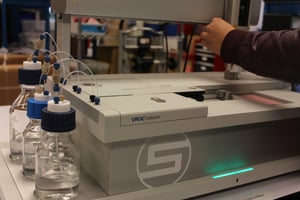RheoSense Process and Software Engineers are responsible for the production of the VROC® Initium one plus product line and know all the tips and tricks to help you get the most out of your instrument. We are sharing just a few of the tips and tricks our team has picked up below!
Tip 1. VROC Sensor maintenance.
At the heart of your Initium lies your VROC chip. Just like the heart in your body, it requires care and maintenance. One of the most common problems we encounter when examining VROC Sensors is that a majority of the sensors fail due to lodged microscopic fibers within the flow channel, obstructing the flow of any samples. To avoid this from happening, it is essential that samples going through the chip have been properly and completely filtered for any micro particulates and fibers (less than 2μm). This not only includes your samples but even more importantly the cleaning solution, buffers, or solvents in the Solvent Jars. This is because during cleaning, a relatively large volume of solvent runs through the VROC Sensor.
Tip 2. Proper Sample Preparations.
One of the most common reasons for invalid or no useful data comes from improper sample preparations, as majority of errors stem from bubbles in the sample. To counteract sample loading errors, it is essential to centrifuge your sample in the RheoSense approved insert, which are individually tested for maximum reliability. As a general guideline we recommend at least 5 minutes at 10,000 rpms, but extending the duration will not hurt and may further help remove any lingering bubbles in your sample. Another common problem we see with sample preparation is the use of non-RheoSense approved vial and insert which do not meet our extremely high level of accuracy which may in the end effect your results.
See How to Remove Bubbles From Your Samples or Properly Loading Your Sample via Backloading
Tip 3. Proper Protocols.
Human error will always be a factor in any given experiment, but the most common error we see is the selection of the wrong protocols. Before starting any job, it is recommended that you double check to make sure that the solvent in the solvent jar matches the Sample Loading Protocol and cleaning Protocol that you have selected. The Initium has no way of detecting what solvents are in the solvent jars except for what you input into the Initium software and indication of any problems will show up as errors in your viscosity measurements.
Tip 4. Consumable Use Count.
To maintain proper care of your Initium and stay confident in your results, it is imperative to keep a watchful eye on the use counts of the consumables and replacing them when needed. This is because after those parts pass over their tested limits, we discovered that this can ultimately affect yours readings which can jeopardize the reliability of your instrument.
If you are looking for routine maintenance or calibration services or have any questions contact us to speak with one of our viscometer experts. Routine calibrations are included with our viscometer service contracts. Request more information about our service contracts here!
Written by: Brandon Bell, RheoSense Process Engineer


